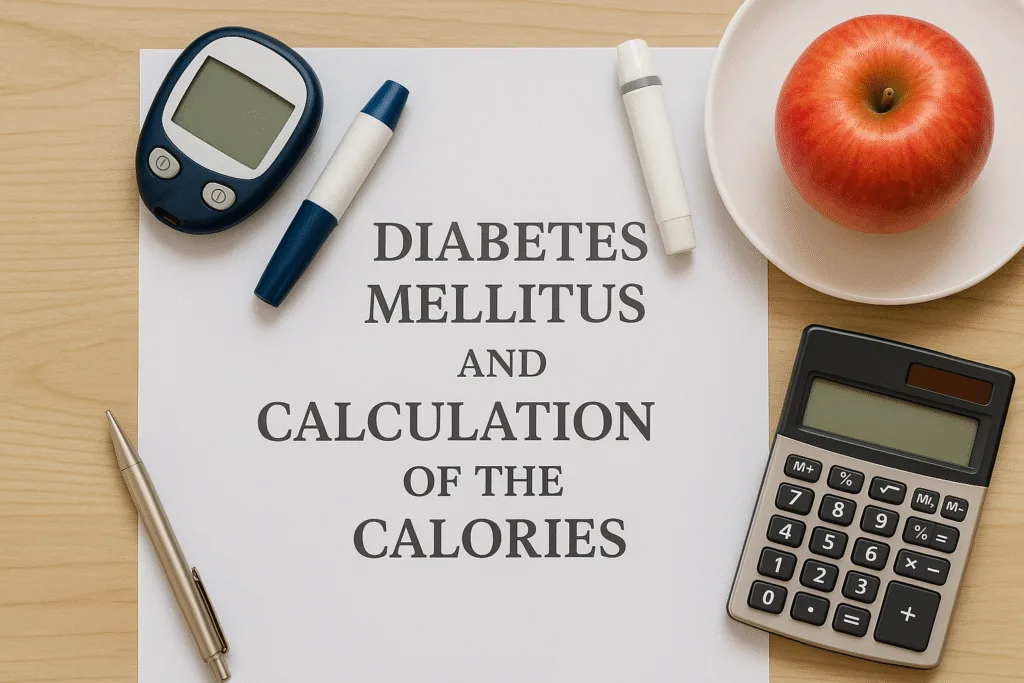Diabetes Mellitus and Calculation of the Calories A Guide to Managing Your Health
Living with diabetes can be overwhelming, especially when it comes to managing diet and counting calories. Understanding the relationship between Diabetes Mellitus and Calculation of the Calories is crucial in maintaining optimal blood glucose levels and overall health. This guide will delve into the science behind diabetes, the importance of calorie calculation, and practical tips to navigate daily meal planning.
What is Diabetes Mellitus?
Diabetes Mellitus is a chronic metabolic disorder characterized by high blood sugar levels. It occurs when the body either doesn’t produce enough insulin (Type 1 diabetes) or cannot effectively use the insulin it produces (Type 2 diabetes). There is also gestational diabetes, which occurs during pregnancy.
Regardless of the type, all forms of diabetes require careful monitoring of dietary intake, physical activity, and medication to maintain healthy blood sugar levels. Among these, nutrition plays a central role, making the Diabetes Mellitus and Calculation of the Calories a vital part of disease management.

Why Calories Matter in Diabetes Management
Calories represent the energy that food provides. For individuals with diabetes, understanding and managing calorie intake can directly affect blood glucose control. Consuming too many calories can lead to weight gain, which increases insulin resistance. Conversely, too few calories may lead to hypoglycemia (low blood sugar), especially if insulin or other medications are involved.
Balancing energy input and output is essential, which is where the relationship between Diabetes Mellitus and Calculation of the Calories becomes central. Proper calorie calculation ensures not only optimal weight management but also helps prevent blood sugar spikes and crashes.
Macronutrients and Their Impact on Blood Sugar
To understand the role of calories in managing diabetes, it’s important to know where calories come from. The three main macronutrients—carbohydrates, proteins, and fats—contribute to the total calorie count.
- Carbohydrates: Each gram provides 4 calories. They have the most direct impact on blood glucose levels.
- Proteins: Each gram provides 4 calories. They have a minimal effect on blood sugar but help with satiety and muscle maintenance.
- Fats: Each gram provides 9 calories. While they don’t directly raise blood sugar, excess intake can contribute to weight gain.
Balancing these macronutrients is a key component in understanding Diabetes Mellitus and Calculation of the Calories effectively.
How to Calculate Daily Caloric Needs
Before planning meals, it’s essential to know how many calories you should consume daily. This depends on several factors:
- Age
- Gender
- Weight
- Height
- Physical activity level
- Type and duration of diabetes
A common method to estimate daily caloric needs is the Mifflin-St Jeor Equation:
For men:
Calories/day = 10 × weight (kg) + 6.25 × height (cm) – 5 × age (years) + 5
For women:
Calories/day = 10 × weight (kg) + 6.25 × height (cm) – 5 × age (years) – 161
This calculation gives the Basal Metabolic Rate (BMR). Multiply BMR by an activity factor (ranging from 1.2 for sedentary to 1.9 for very active) to get your Total Daily Energy Expenditure (TDEE).
Once you know your TDEE, you can adjust your calorie intake based on your goals—whether it’s weight maintenance, loss, or gain. This calculation ties directly into understanding Diabetes Mellitus and Calculation of the Calories for personalized nutrition plans.
Glycemic Index and Glycemic Load
When considering Diabetes Mellitus and Calculation of the Calories, it’s not just the quantity but also the quality of the food that matters.
- Glycemic Index (GI) measures how quickly a carbohydrate-containing food raises blood glucose.
- Glycemic Load (GL) considers the GI and the carbohydrate content in a typical serving.
Foods with a low GI/GL are better choices for people with diabetes, as they lead to slower, more stable rises in blood glucose. Examples include whole grains, legumes, non-starchy vegetables, and some fruits like berries and apples.
Sample Calorie Calculation for a Diabetic Meal Plan
Let’s say you’ve calculated your daily calorie requirement as 1800 kcal. Based on the recommended macronutrient distribution:
- Carbohydrates: 45-60% → 810–1080 kcal → 203–270g/day
- Proteins: 15-20% → 270–360 kcal → 68–90g/day
- Fats: 20-35% → 360–630 kcal → 40–70g/day
Here’s a sample meal plan showing how Diabetes Mellitus and Calculation of the Calories can work in practice:
Breakfast (400 kcal):
- 1 boiled egg (70 kcal)
- 1 slice whole grain toast (80 kcal)
- 1 small apple (80 kcal)
- 1 cup unsweetened almond milk (30 kcal)
- 1 tbsp peanut butter (120 kcal)
- Coffee or tea (0 kcal)
Lunch (500 kcal):
- Grilled chicken breast (150 kcal)
- Mixed greens with vinaigrette (100 kcal)
- Quinoa, ½ cup cooked (110 kcal)
- Steamed broccoli (40 kcal)
- Greek yogurt, plain (100 kcal)
Dinner (600 kcal):
- Baked salmon (250 kcal)
- Brown rice, ½ cup (110 kcal)
- Steamed asparagus (30 kcal)
- Mixed fruit salad (100 kcal)
- Olive oil dressing (110 kcal)
Snack (300 kcal):
- Handful of almonds (160 kcal)
- Small banana (90 kcal)
- 1 string cheese (50 kcal)
These carefully balanced meals are an example of how to implement Diabetes Mellitus and Calculation of the Calories in daily life.
Tools to Help with Calorie and Carb Counting
Several digital tools and apps can assist with Diabetes Mellitus and Calculation of the Calories:
- MyFitnessPal: Tracks calories, macros, and exercises.
- Carb Manager: Designed for low-carb and diabetic-friendly tracking.
- Diabetes:M: Offers glucose monitoring and nutrition tracking.
- CalorieKing: Great database for food calories and carbohydrates.
These tools simplify meal planning, track progress, and improve adherence to dietary goals.
Tips for Managing Diabetes Through Calorie Awareness
- Read Nutrition Labels: Always check for serving size, calories, and carbohydrate content.
- Practice Portion Control: Use measuring cups, food scales, or hand-size guides.
- Limit Added Sugars: Opt for naturally sweet foods like fruits.
- Choose Whole Foods: Less processed foods have lower glycemic impact.
- Stay Hydrated: Sometimes thirst is mistaken for hunger.
- Plan Meals Ahead: Prevent impulsive and unhealthy eating.
By integrating these habits, Diabetes Mellitus and Calculation of the Calories becomes a smoother process.
The Role of a Dietitian in Managing Diabetes
A registered dietitian (RD) or certified diabetes educator (CDE) can create individualized meal plans based on your health goals, lifestyle, and medical history. They can teach you how to incorporate Diabetes Mellitus and Calculation of the Calories into your routine, adjusting it as your needs evolve.
Special Considerations for Different Populations
For Children with Diabetes:
Caloric needs are higher due to growth demands. Accurate calorie counting ensures appropriate growth without risking hyperglycemia.
For Older Adults:
Caloric needs may decrease with age and reduced activity. Nutrient-dense foods become more critical to meet vitamin and mineral requirements.
For Pregnant Women:
Gestational diabetes requires careful monitoring of both calories and blood glucose. Nutritional needs increase, making Diabetes Mellitus and Calculation of the Calories even more crucial.
Common Myths About Calories and Diabetes
Myth 1: “Carbs are bad for diabetes”
Carbohydrates are essential for energy. The key is choosing the right type and amount.
Myth 2: “Only sugar affects blood glucose”
All carbohydrates, including those from bread, pasta, and fruits, influence blood sugar levels.
Myth 3: “Calories don’t matter if I’m on insulin”
Even on insulin, overconsumption of calories can lead to weight gain and worsen insulin resistance.
Disproving these myths helps deepen our understanding of Diabetes Mellitus and Calculation of the Calories.
Final Thoughts
Managing Diabetes Mellitus and Calculation of the Calories isn’t just a one-time task—it’s a lifelong commitment to health. Calorie awareness helps control weight, manage blood sugar, and reduce the risk of complications such as heart disease, neuropathy, and vision problems.
With the right tools, knowledge, and support, managing diabetes through calculated calorie intake can become second nature. Whether you’re newly diagnosed or looking to refine your approach, integrating Diabetes Mellitus and Calculation of the Calories into your lifestyle is a foundational step toward lasting wellness.



